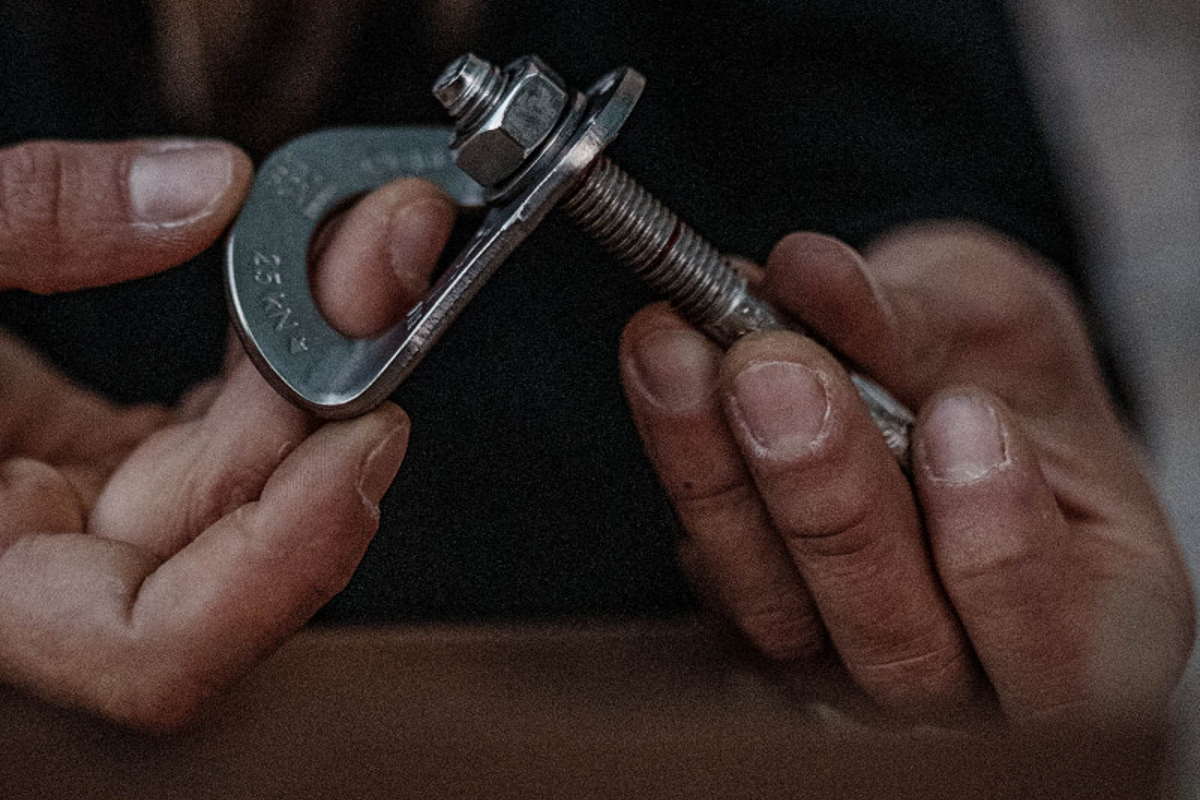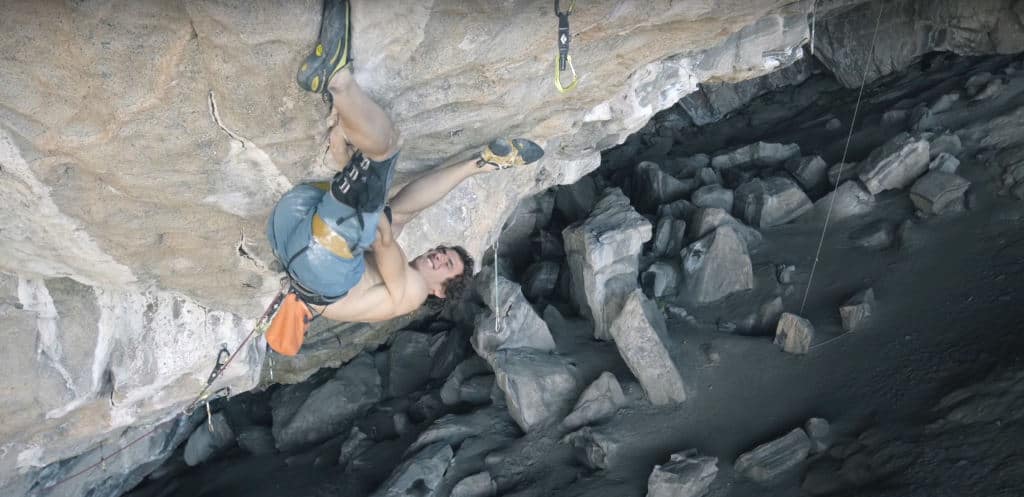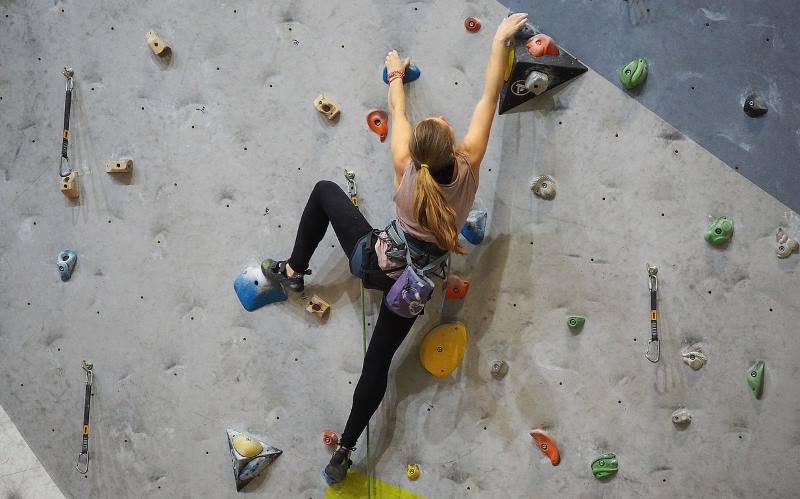In 2018 the whole world seemed to be watching the same horror story play out live on our screens. Twelve young Thai kids and their soccer coach had become trapped four kilometers into a cave system. At first, even finding them alive after ten days seemed impossible.
Now ‘The Rescue‘ is the first documentary to show the inner workings of this immensely dangerous mission. It’s directed by Elizabeth Chai Vasarhelyi and Jimmy Chin, who also directed the award-winning Free Solo.
Thai Cave Rescue Story
If you didn’t get caught up in the story of the Tham Luang rescue back when it was happening – we’ll try not to spoil it for you. On June 23rd of 2017 a soccer coach for the “Wild Boars” took his team of twelve kids – aged 11 to 16 – to a cave on their bicycles for a day out.
The limestone cave system runs under the mountain of Doi Nang Non in Chang Rai and runs over 10 kilometers (6.4 miles), starting with a huge opening to the East. The cave entrance narrows and follows a curve to the west, curving and winding up and down for 1.8 km. From there it splits into two long sections, one going to the north which is less explored.
A second, southward path leads another 2 kilometers further and features false paths leading to dead ends, with many difficult winding sections of only a single body width. The cave generally becomes flooded and is closed much later in the year, but the monsoon season had started much earlier than normal.
The boy’s families only found out where they had gone after frantic searching by another coach led to the discovery of their bikes near the cave’s mouth. Local authorities were alerted but with no serious cave diving team in Thai authorities, it fell to the relatively inexperienced but dedicated Thai navy seals to mount a search.
What happened to the team is that water seeped in from overflowing rivers on the mountain above the cave. At first, the team thought the river being at ankle height was normal. By the time they’d gone in far enough, after turning back they found entire chambers completely flooded.
Within the day a British caver who lived in the area – Vern Unsworth – was contacted. He’d already been planning to dive the cave and had previously mapped out much of the system. He immediately recommended that the British Cave Rescue Council should be contacted and gave a hand-written list of the best cave divers in the world to the Thai military.
Within a few days, three of the BCRC divers had arrived, followed by experienced teams from the US military, Australian police force, and Chinese rescue specialists. Their first mission was to get through the caves and find if the boys were even alive.
What they found was not just a flood, but a strong river of mud and silt that was almost completely impossible to see through, let alone find a way through. The team found themselves struggling to survive and at one point decided the risk to their own lives was just too high.
Thai Cave Rescue Documentary
‘The Rescue’ as a documentary does a great job of pulling together media from the divers themselves, newsreels from the thousands of reporters from around the world, some on-site filming, as well as reconstruction of the rescues.
It weaves together the tale of the rescue mainly from the point of view of the British team that was called in and did the majority of the exploration, rope setting, and then the rescue itself. Divers from France, Belgium, and Australia were also majorly involved in as well as hundreds of Thai divers, volunteers, and river workers.
The film does pretty well at handling the vast network of people involved and highlights the massive work of redirecting entire rivers on the top of the mountain to try and avoid further flooding.
As a film, it succeeds for the Western audience mainly because there was an English-speaking team available for in-depth interviews. The ultra-specific personalities you might expect of the handful of people dedicated to cave diving at the highest level provide much of the intrigue. Their backgrounds and early lives are probed to give a deeper insight into just why they might enjoy the obscure and dangerous hobby of cave diving.
The ups and downs are charted day by day, with the team at multiple points either giving up completely or believing their thin plan will break. The strong chance that they would end up killing the children in a rescue was heavily shadowed by the possibility of prosecution and imprisonment shortly after.
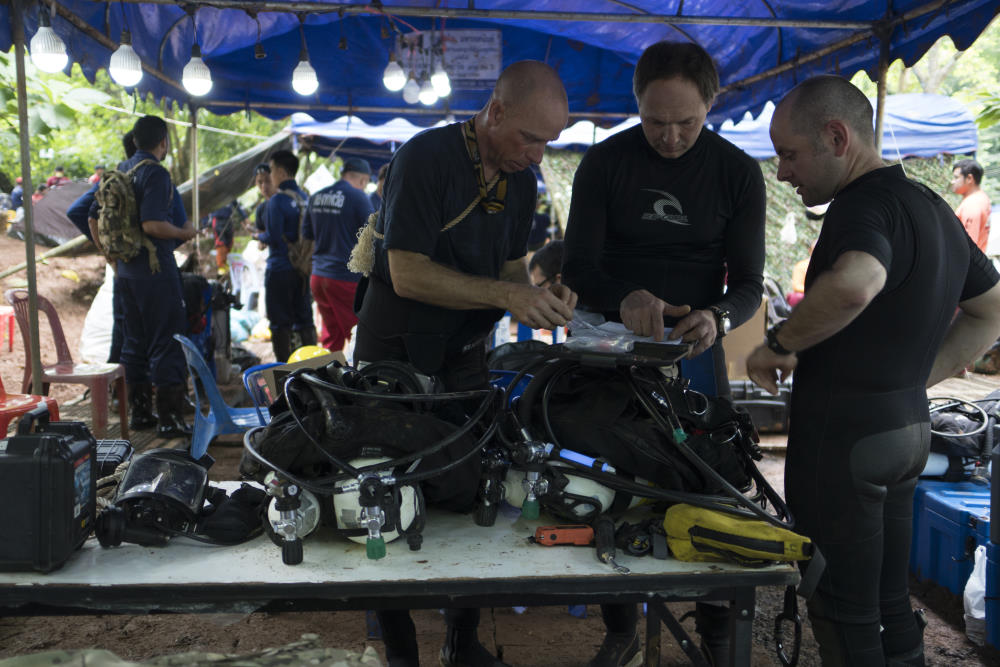
‘The Rescue’ Review
With all of these factors at play, ‘The Rescue’ does a great job of pulling together a tense story with excellent pacing. It’s a film you can’t stop watching but almost can’t believe actually happened in the way it did.
The reconstructed shots are done well enough that without rewatching you probably won’t know they aren’t real. The mix of footage between high-quality reconstruction, mixed GoPro shots, and face-to-face interviews isn’t too jarring either.
In terms of criticisms, the film is aimed at a wide audience and has the overall message of human perseverance. As a result the music sometimes veers into being a little cheesy but nothing obnoxious (bar the ending credits song).
It also doesn’t go very in-depth into the Thai people involved in the rescue effort or family viewpoint. It does feature a few locals who were involved in some ways, but none of the boys, the close family, or the Thai Navy involved.
This is likely because the boys and their families have signed exclusive contracts with Netflix. The military also has many faces blurred because they are on active duty and some are barred from media interviews.
Overall, we’d absolutely recommend you watch ‘The Rescue’. It tells the story of the whole event incredibly well and gives a real insight into the horrific and life-threatening conditions the divers were faced with. It has really high production values and makes you feel a part of the chaos of the caves.
Watch + Stream ‘The Rescue’ Online Now
The best way to stream ‘The Rescue’ online is at Disney+. You can also watch ‘Torn‘ at Disney+, a film on Alex Lowe we highly recommend. It features an interview with Jimmy Chin who directed ‘The Rescue’
From here we’re answering many of the common questions about the Thai cave rescue. Expect lots of spoilers for the movie ahead!
Is Tham Luang Cave Open?
The cave the boys were trapped in is now open to the public but not completely. It also has many more restrictions to avoid another accident. It’s also closed completely in the rainy season.
Initially, the cave was sealed off with armed guards making sure no one was able to attempt a sneaky look back in. After many months and the monsoon season over, the cave was reopened with extensive work from various teams over a year later. It’s possible to visit but under much stricter circumstances and with certain areas out of bounds.
Seven months later, many areas of the cave were still flooded and no further exploration was possible until the next year. Now, much of the cave is now almost impossible to access because the unusually long monsoon season that trapped the boys lead to significant dumping of mud and sand in the cave. This means where the cave could be walked (or crouched) though previously, there is no visible entrance.
A team has done extensive digging out of some of the sand and crawled through to take a look at the chambers the boys were in. They believe that had the boys not been taken out within the small time frame they were, they would have died.
There is a great blog here with videos by the team that re-opened some of the tunnels with digging. They also helped with the effort to remove much of the diving equipment and waste that was left during the rescue effort.
You can see a cool video where National Geographic has reconstructed the cave from 3D scans made by a new team below.
Directors Elizabeth Chai Vasarhelyi and Jimmy Chin
Elizabeth Chai Vasarhelyi and Jimmy Chin are married and have now directed three films together. Meru was the first film they worked together on and saw Jimmy himself with Conrad Anker and Renan Ozturk attempting to summit the Meru peak in the Indian Himalayas.
The film won the audience documentary award at the 2015 Sundance Film Festival and we rate it as the best mountaineering documentary in our list of favorites. Jimmy Chin still manages to balance his own personal climbing with a serious amount of outdoors and adventure photography and filmmaking.
Free Solo was their next work and will maybe go down as their most historic piece. We’d be surprised if you haven’t yet seen it. The film follows the prolific free soloist Alex Honnold as he works up to attempting to climb El Capitan in Yosemite, sans rope.
This film not only catapulted Alex Honnold into mainstream fame, but it also won an Oscar and seven Emmy awards for the directors and crew. As a result of the popularity, Jimmy now essentially has free roam to film and direct anything he wants with Elizabeth – which is excellent for outdoor enthusiasts.
They’ve also directed, produced, and worked as camera crew on other shorts and TV series. They are due to release a new film ‘Nyad’ fairly soon on Netflix. It’s the directors’ first narrative film, featuring the life story of Diana Nyad who at 64-years old swan 100 miles from Cuba to Florida.
Why Were They In The Cave?
The team went into the cave as a day trip after training. The plan was to go to the back of the cave and write their names on a wall. The cave wasn’t flooded at that point but they did have to wade through water in some sections.
Some sources say this was part of a ceremony or “rite of passage” to joining the team. Others say that they were celebrating one of the boy’s birthdays there, and had brought a lot of snacks they planned to eat in the cave.
The Chang Rai area floods a lot in the rainy season, so this isn’t something the boys wouldn’t have done before. However, the rain seeped in from cracks in the mountain above, as well as from the cave system in the opposite direction – quickly blocking their escape.
How Did The Thai Soccer Team Survive?
Before being rescued, the twelve boys and their adult coach survived completely alone for nine days. They had no contact with the outside world, one small flashlight, a handful of snacks, and very little water.
Their coach refused to eat any of the food, and just a few days in they had no food and no light. Humans survive without food for two to three weeks at a push but not as long without water – only around three days. To survive they collected water from the dripping stalactites above them and meditated to calm themselves and use less oxygen.
Despite everything, they managed to hold on until rescue came – though when the first divers reached them they didn’t have any food to give them. Within the day they managed to get them food and messages from outside, as well as beads blessed by a local monk.
Who Were The Cave Divers Involved In The Thai Cave Rescue?
There were quite a few divers involved in the Thai cave rescue but the most experienced were the pair from the UK – John Volanthen, and Richard “Rick” Stanton. They were accompanied by Robert Harper on the first visit by an outside team. All of them have been cave diving and caving for decades, and had been involved in previous rescue attempts and body recoveries.
Both Rick Stanton and John Volanthen were given George Medals by Queen Elizabeth II and Prince William. In fact, Rick Stanton had already been given an MBE for his work as a firefighter.
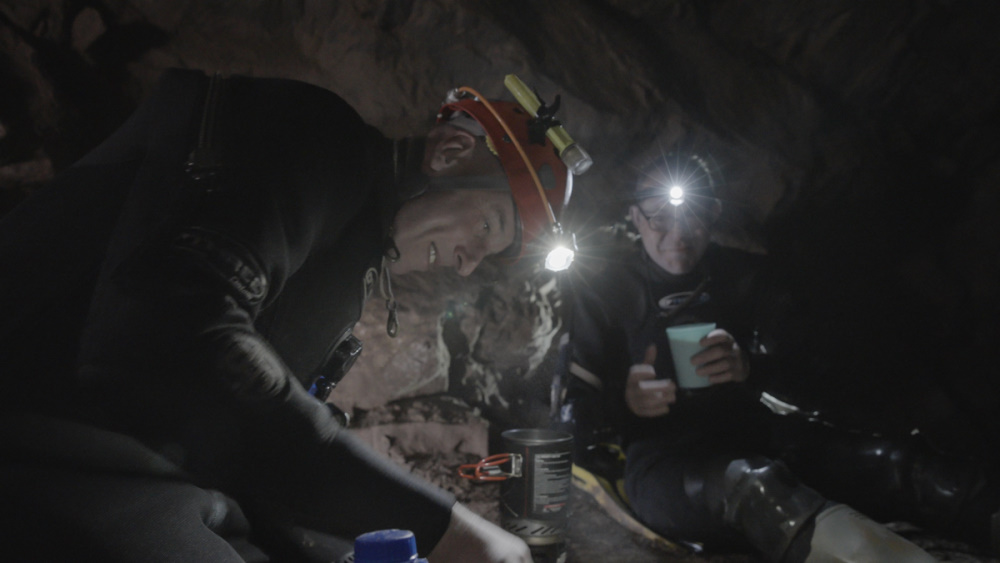
Richard Harris is an anesthetist and experienced cave diver who joined in to advise on a plan to sedate the trapped team and assist in the rescue. He came along with diving partner Craig Challen who was previously a veterinarian who has made record-breaking dives. Both were awarded the Australian Of The Year, the Star of Courage, and the Order of Australia.
Belgian diver Ben Reymenants was very involved in the initial laying of the line, as well as his dive partner from France Maksym Polejaka. Maksym lives in Phuket and worked as a boat builder, but previously worked as a dive instructor for Ben who lives and instructs in Phuket and Singapore.
Many of the European and UK teams were part of the British Cave Rescue Council, who volunteer to do search and rescue missions in caves in the UK and abroad. Jason Mallinson, Josh Bratchley, Connor Roe, and Chris Jewell were all Brits that helped in the rescue.
Vern Unsworth was a Brit who had lived in the area for years and explored this cave system and mapped it before. He helped as an advisor onsite, giving the Navy team details of the caves, initiating contact with the British Cave Rescue Council, and helping the dive team.
Many from the Thai navy were involved in the diving – doing the initial search, establishing camps, putting in ropes, ferrying supplies, and more. Lieutenant Colonel Pak Loharachun was part of the Thai team that went into the cave, he gave them medical attention and stayed with them.
Many aren’t named because they are on active duty. The King of Thailand awarded 74 Thais the Most Admirable Order of the Direkgunabhorn for their work in the rescue, as well as 144 of other nationalities.
Master Sergeant Derek Anderson, Captain Mitch Torrel, Master Sergeant Kenneth O’Brien, and other US Air Force divers were involved in the rescue. US Navy SEAL divers were a big part of the diving, coordination, and rescue efforts.
Ivan Karadzic is an experienced cave diver who owns Koh Tao Tec Divers. Mikko Paasi is a Finnish diver who owns Koh Tao Tec Divers and works at Koh Tao Divers. Claus Rasmussen is a Danish diver who has instructed in Thailand for years.
Erik Brown is a Canadian who works as a diving instructor in Koh Tao with Mikko, he’s also a successful underwater videographer. He was awarded the Silver Medal For Bravery by the Lieutenant Governor of British Columbia.
An American – Josh Morris – is a caver and instructor who lived in the area and spoke fluent Thai. He helped translate between the teams with knowledge of the technical terms and real-life experience of working in caves like Tham Luang.
There were also a lot of rope specialists who set up rigging from the start of the dry sections of the cave to the entrance. That meant as soon as the boys were on dry land they were hoisted onto a suspended line and pulled out as fast as possible.
Thai Cave Rescue Divers & Advisors
- John Volanthen GM – UK
- Richard ‘Rick’ Stanton GM MBE – UK
- Richard ‘Harry’ Harris SC OAM – Australia
- Craig Challen SC OAM – Australia
- Chris Jewell – UK
- Jason Mallinson – UK
- Jim Warny – Belgium
- Josh Bratchley – UK
- Connor Roe – UK
- Robert Harper – UK
- Vern Unsworth – UK
- Ben Reymenants – Belgium
- Maksym Polejaka – France
- Erik Brown – Canada
- Claus Rasmussen – Denmark
- Tan Xiaolong – China
- Mikko Paasi – Finland
- Ivan Karadzic – Denmark
- Lieutenant Colonel Pak Loharachun – Thailand
- Sergeant Saman Gunan – Thailand
- Petty Officer Beiret Bureerak – Thailand
- Colonel Singhanat Losuya – Thailand
- Master Sergeant Derek Anderson – USA
- Msster Sergeant Kenneth O’Brien – USA
- Captain Mitch Torrel – USA
Did All Of The Thai Soccer Team Survive?
Yes – incredibly all twelve of the children and their coach survived the ordeal. The entire “Wild Boars” team made it out without injury, though they had all lost a significant amount of weight. Thanks to the incredible and concerted effort from a variety of countries and specialties, everyone who was originally trapped made it out.
One of the boys developed hypothermia (a dangerously low body temperature) while being helicoptered from the cave to the hospital, but recovered well. All were choppered out and treated for minor cuts to their feet and legs from the sharp cave floor.
They lost on average 2kg (4.4lbs) of weight each and were fed with a simple diet of rice porridge for the first ten days after the rescue.
Did They Sedate The Thai Soccer Team?
Yes, the only way the team could see a rescue would work would be if the boys were sedated on the way out. Cave diving induces panic very fast, and with such a long route the divers were worried the boys would panic, breathe too much and use up their oxygen, or try to escape and end up drowning.
They realized this because on their very first dive they found some pump workers who had fallen asleep. Water levels had risen behind them and they’d become trapped with no one else realizing. The two divers only had to bring them through a short section that would take less than a minute, but the adults all panicked and tried to break free.
Trying to do the same with kids for a much longer journey of over two hours underwater would probably have meant a panicked death for some of them. So Rick thought up the idea originally of sedating the boys. He texted an old friend, Richard Harris, an experienced cave diver and anesthetist to ask if it was possible.
Initially, Harris thought it was impossible, as well as irresponsible. However, over the course of a few weeks, the team figured out what they thought would be the best possible mix of sedatives. Harris also gave the team of divers a crash course in injecting the children as they would have to stop periodically in isolated sections to administer more of the sedative.
The main sedative given to the children was Ketamine as a general anesthetic, Atropine to lower their heart rate and breathing, as well as dry out saliva to stop them growing themselves, as well as Xanax to calm them and keep them sleepy. The key part of this was that full-face masks were used so the boys didn’t need to bite down on anything to breathe.
Did The Coach Get In Trouble?
No, the soccer team’s coach Ekapol “Ek” Chanthawong wasn’t charged or sacked, though there was some bad sentiment locally quite early on. Soon, people realized that this was a completely random accident. The coach was actually key in keeping the children calm, guiding them through meditation to lower their heart rates and oxygen used.
The coach received very little money for coaching the soccer team and spent a lot of time with them outside of his job – cycling and taking them out on activity days. At a young age, he lost his mother, father, and only brother to illness. At the age of 10, he was an orphan and lived in a monastery for the next decade practicing as a Buddhist monk.
For a while, Ek did remain their coach but has since moved on to another team so the kids could focus more on their football and not the past.
Were The Divers In Danger?
The risk of death to the divers was absolutely real. Even very experienced cave divers can get disorientated in the dark because of the silt and dirt, especially if they lost the guide rope. In fact, one diver involved in the rescue got lost after losing hold of the rope and accidentally went back to the wrong cave. He then required a small rescue himself.
One of the other risks is that if one of the children had died, the Thai authorities may have prosecuted those involved. The British embassy had an escape plan for some of the divers to shuttle them out of the country if things looked bad. The Australian embassy negotiated for the Australian divers to get diplomatic immunity so they could avoid prosecution if the rescue didn’t go well.
Did Anyone Die In The Thai Cave Rescue?
Sadly yes, two rescuers died in their attempt to reach and supply the trapped soccer team. Sergeant Saman Gunan was a former Thai Navy SEAL who volunteered to come back and help in the rescue. While coming back from delivering air tanks to the boys, he became trapped in a small section and ran out of oxygen – dying of asphyxiation.
Another Thai Navy SEAL – Petty Officer Beirut Pakbara – also died nearly two years after the rescue due to a blood infection he contracted during the mission.
There were some other close calls. The first Thai team to reach the kids was meant to bring and leave one medic and one officer to keep morale high, with other support divers also bringing food and returning to the entrance. They were inexperienced with cave diving and a few members nearly used up all of their oxygen. This meant four of the Thai Navy had to stay with the kids and would have to be rescued themselves a little later.
Could The Soccer Team Wait For The Water Levels To Go Down?
The cave flooded earlier than normal because the rainy season had started earlier. As a result, during the mission, the cave was constantly at risk of more flooding and worse conditions. The cave was being flooded from the East, as well as from gaps in the mountain above.
This meant that waiting could take anywhere from 3 to 6 months for the caves to drain enough for either the team to walk out or enough for them to do small tankless dips between sections. The option was on the table.
There was a huge amount of work to remove water from the caves and stop water from coming in. As a result much of the first part of the system was drained and the sandy floor dug up to create a walkway. Even with extensive work from thousands of people, the caves still took hours to dive through.
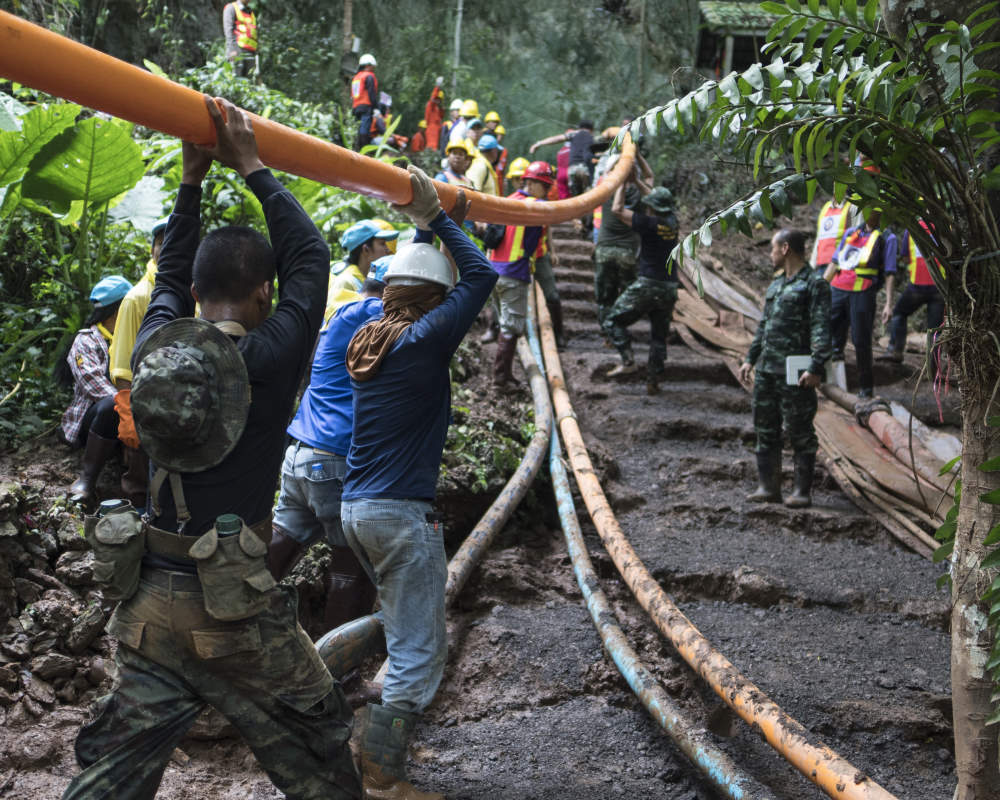
However, there were multiple problems with waiting. The air in the cave was constantly running out, food was very hard to get to the team, sanitary conditions were terrible and could cause respiratory infections, the cave could become further flooded, and some of the team were already suffering from medical issues.
Essentially the team had a do-or-die situation. Either they risked a rescue and possible loss of life or essentially guaranteed the team’s slow death.
How Much Air Did The Thai Soccer Team Have?
In the film, they show the dive team measuring oxygen levels in the last cave where the kids were at around 15%. Normal air has around 20.9% oxygen content. At 17% a person’s judgment may start to become impaired. Below this breathing becomes more rapid, fatigue increases, followed by nausea, mental failure, loss of consciousness, and eventually the person will lapse into a coma and die.
The air used by the divers to get to the kids used nearly half of a full tank, meaning they would have just enough to get back if they swam perfectly without any hard breathing. As a result, full air tanks had to be stashed along the route. This allows rescuers to swap tanks for the kids as they brought them out.
How Long Did The Thai Cave Rescue Take?
It took 17 days for the Thai Cave Rescue from the team becoming lost through to everyone coming out. June 23rd is when the team entered the cave, and the last of the group to be rescued came out on July 10th. It’s estimated over 10,000 people were involved in the rescue from supply lines, divers, experts, pump workers, soldiers, helicopter pilots, medical professionals, and administration and organization.
How Much Did The Thai Cave Rescue Cost?
One estimate believes that the rescue of the boys may have cost around $500 million US dollars. It is a complete estimate but really, because of the huge amount of workers, specialist equipment, transport, pumping, drilling, and travel for the people involved – it definitely cost a massive amount.
One source puts the cost of rescue to the government at around 300 million Thai baht, or around $9 million US dollars.
That being said, all of the specialist cave divers volunteered their time and effort for no cost. Their flights were mainly paid for by themselves or international rescue organizations that already have funds allocated. Some even left expensive gear behind to make the rescue go faster.
The Thai government did pay for all of the volunteers’ flights home and gave some of them what’s called a “Thailand Elite Card“. It gives them visa-free travel to Thailand for five years and one expenses-paid free trip.
Most Thai people involved also volunteered their time freely, including ex-Navy SEALs. A lot of the workers involved didn’t leave the site of the cave for the full three weeks of the operation and clear up.
How Did They Film The Thai Cave Rescue?
Footage was used from a wide variety of sources including directly from the various European divers, Thai Navy, US military, and news organizations. Apparently, there was around 87 hours of footage from the Thai SEALs alone.
Some of the footage in the documentary is reconstructed from filming in similar caves in Thailand and in the UK. Most of the filmed footage is from personal GoPro’s the divers used.
Will There Be A Thai Cave Rescue Film?
Yes, there are actually a few films being made of the Thai cave rescue. Expect this to be dragged out for a while.
There will be a big-budget US film production reproducing the events of the original rescue. ‘Thirteen Lives‘ is currently in production by MGM and will star Colin Farrell, Joel Edgerton, Viggo Mortensen, and Tom Bateman. It’s directed by Ron Howard (director of ‘Apollo 13’ and ‘Solo: A Star Wars Story’) due to be released on November 18, 2022.
‘The Cave’ is a Thai production and was released in November 2019. It features some filming on-site at the Tham Luang Nang Non cave and some at other similar caves in Thailand. It also features some of the original divers Jim Varny, Erik Brown, Mikko Paasi, and Tan Xiaolong.
Netflix will be producing a limited series that seems to focus much more on the soccer team themselves. Netflix bought exclusive rights to their stories – which is probably a reason why so little about them was featured in ‘The Rescue’.
There’s also a short documentary called ’13 Lost’ on Amazon that uses footage and interviews from one of the divers Ben Reymenant. There is also another documentary available for free on YouTube here that features a lot of good footage and interviews.
Why Did Elon Musk Get Involved?
Elon Musk inserted himself into the rescue effort about a week into the ordeal. He offered to try and help by some means, which ended up with a small submarine-type pod being made by some of the engineers at Tesla and SpaceX.
He was in contact with Thai authorities as well as one of the divers on site. However, another diver was highly critical of the sub’s usefulness and Elon trying to help. Elon took huge offense and called the diver “pedo guy“.
The sub didn’t get used – though Thai Navy officers were given some training on how they might use it in a similar situation. The diver later took Elon to court for defamation, seeking $190 million in damages. Elon won the case though did apologize.
What Is A Sump In Cave Diving?
A sump is simply a dip in a cave’s passage that has been filled with water. It could be simply that water runs through from another path in the cave, or that there is a hole above this section where rainwater can run into.
Depending on the cave there could be largely walkable passages with some sumps or one continuous sump aka a fully submerged cave with just certain pockets of air or land. The film mentions the word sump multiple times without an explanation.
